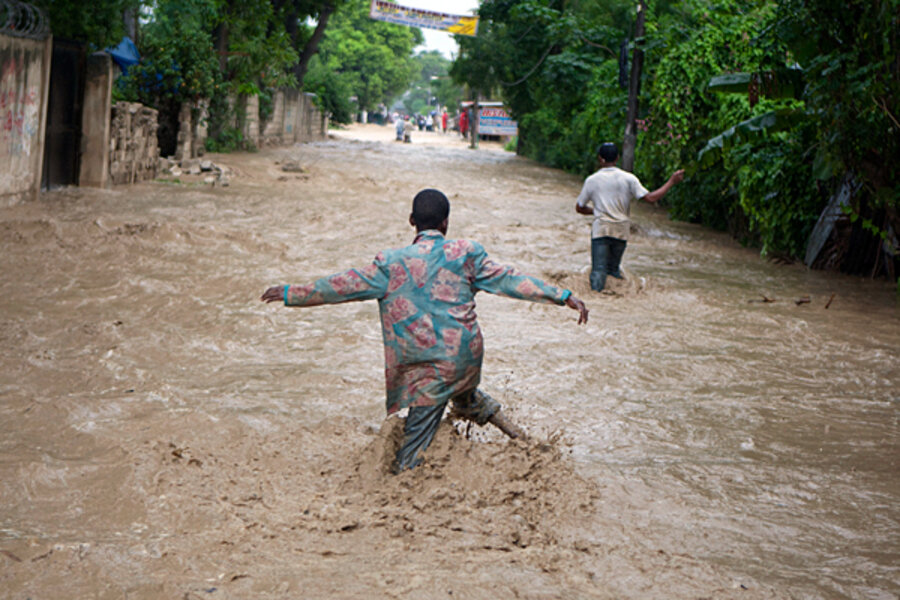Not a trick or a treat: Hurricane Sandy could hit as monster hybrid storm
Loading...
| New York
Hurricane Sandy, currently a dangerous category 2 storm with sustained winds of 105 miles per hour moving north through the Bahamas, could impact the Northeast and even New England early next week, the National Hurricane Center (NHC) said Thursday afternoon.
By the time Sandy gets to the Northeast in the days before Halloween, forecasters think it will have morphed into a monster hybrid storm hundreds of miles wide, a combination of Nor’easter and hurricane, packing sustained winds of 50 mile per hour and pushing a storm surge into low-lying areas.
Government weather forecasters say the probability cone for the storm’s path over the next five days shows Sandy approaching the East Coast from North Carolina on Monday to Portsmouth, N.H., on Tuesday. Although the center of the forecast cone is just south of New York City, it does not mean that is where it will come ashore.
The storm, whose high winds and heavy rains could last for days, could cause widespread power outages and dangerous flooding. By this weekend meteorologists will have more information, and some communities may have to contemplate evacuations, especially along the coastline.
“This storm is dangerous,” says Bryan Norcross, a hurricane specialist at the Weather Channel. “If it comes to pass like the consensus forecast, it will be unprecedented, we have never seen anything that looks like this.”
Mr. Norcross says from a meteorological standpoint Sandy will begin to look like the 1991 “perfect storm” that raked the East Coast with high tides and strong wind, leaving 13 people dead in its wake.
That storm, a combination of hurricane Grace and a massive Nor’easter, derived yet more energy from the jet stream, a river of air that controls weather patterns.
“This combination all coming together is not seen very often,” says Norcross. “It takes just the right configuration in the atmosphere for it all to come together.”
Many different meteorological parts still have to fall into place for Sandy to develop into the type of storm described by Norcross.
For example, an upper level low pressure system will have to move from the Pacific Ocean to the East Coast in three or four days. This low will draw Sandy in from the Atlantic toward the coastline.
“The meteorological mechanism for all this to happen is still out in the Pacific Ocean, and that is a long way to come and a lot can happen,” cautions James Aman, senior meteorologist at Earthworks, the parent company of the WeatherBug in Germantown, Md.
That’s one reason why the NHC is still telling people living in the East not to head for higher ground just yet.
“People in the Northeast and New England should pay attention,” says Dennis Feltgen, a spokesman for the NHC. “You might want to stock some supplies in case the power goes out and be aware of your situation.”
What especially concerns Norcross and other forecasters is that as the storm moves up the coast it may take a left-turn to come onshore. This would result in a storm surge that could pile water up along seaside communities.
“The odds are if this forecast comes to pass and the storm comes in south of New York City, we are talking tremendous damage to Long Island, New Jersey, and New York City itself,” he says.
It won’t help that the storm will be arriving during the full moon, when high tides can run a foot higher than normal.
On Thursday, the Ocean Prediction Center, a government agency, predicted the storm surge from central New Jersey south to around Ocean City, Md. would be 2 feet to 3 feet. From mid-New Jersey to Martha’s Vineyard, including Long Island Sound, the surge is predicted at 1 to 2 feet. The Massachusetts coast north to Portland, Maine, would see a 6-inch storm surge.
The storm will also be carrying a lot of rain with it. Government forecasts predict 3 inches to 5 inches of rain from New Jersey to the Catskills.
“One nice thing is that we have not had a lot of rain recently, so the ground is not saturated,” says Mr. Aman, “But there will be a good portion that will run off, and the rivers and streams will rise.”
Feltgen says his worry is that trees are still carrying a lot of leaves. This might make them more susceptible to being knocked down in high winds. As the trees fall they can bring down power lines. “I think for people, the first concern is what to do if my power is out for a week,” he says.
Last Halloween, a freak snow storm knocked down thousands of trees. Many residents along the East Coast were without power for a week or more.
Another problem for the East is that by the time the storm arrives off the New Jersey coast, the wind field will be massive. The diameter of the storm could be 700 to 800 miles.
“We could have a very long duration wind event, even in Massachusetts,” says Norcross. “The wind is going to blow for the entire week.”







